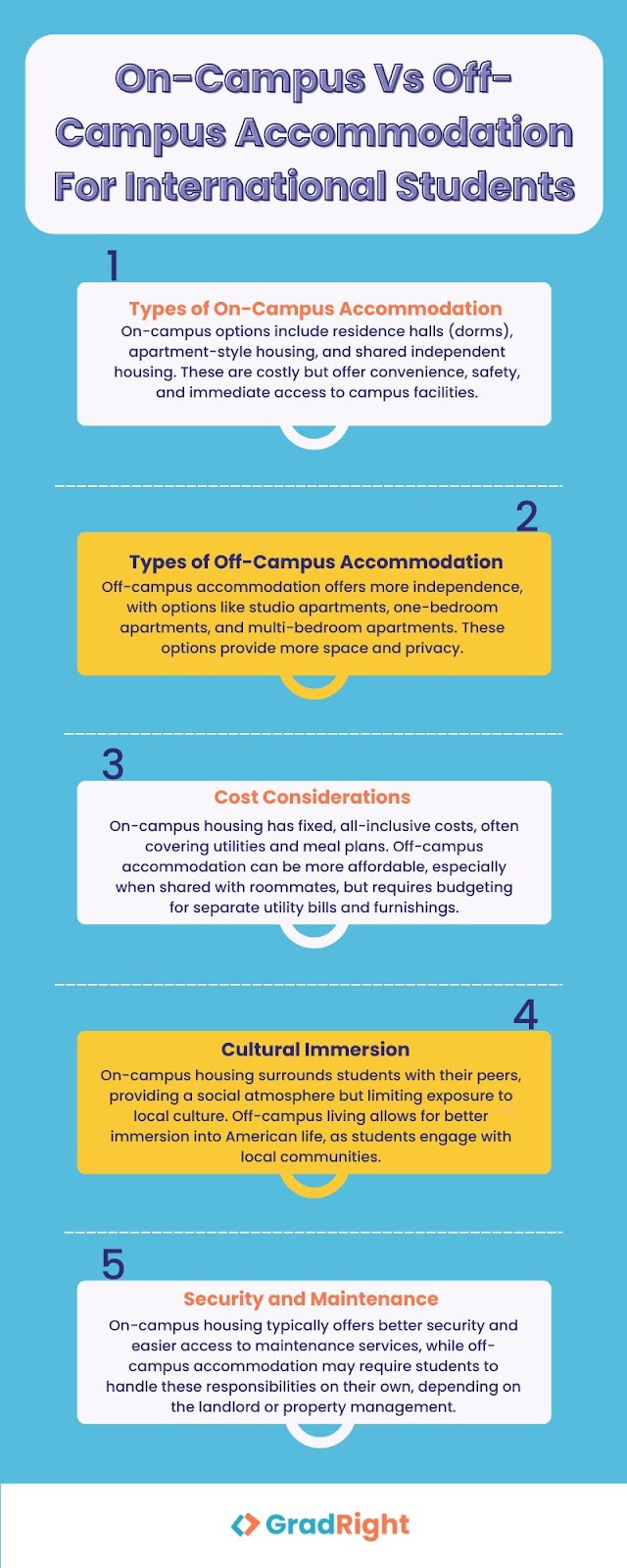Summary
- When in the USA, you will (usually) have the choice to be a resident on the university campus, or to find independent housing.
- When you’re heading to a university in the USA, you will have to choose between on-campus and off-campus accommodation in the USA during college.
- There is usually no scope of having a roommate in a one-bedroom apartment, so this actually works out to be one of the more expensive options because….
When you’re heading to a university in the USA, you will have to choose between on-campus and off-campus accommodation in the USA during college. The choice that you end up making will actually have a significant impact on your budget, lifestyle, and student experience.
That is why understanding the difference(s) between on-campus and off-campus accommodation in the USA is so important. This article will outline all the major points that you need to know, helping you make an informed decision about which to choose.
So without any further ado, let’s get started.

Also Read: Study Abroad Guide for Indian Students
Student accommodation for international students
When in the USA, you will (usually) have the choice to be a resident on the university campus, or to find independent housing. Some universities also have a rule that first-year students (freshmen) need to be on-campus for year one, and can move off-campus from years two through four. Postgraduate students, on the other hand, usually have the choice of living off-campus from the start of their degree itself.
So, which should you choose, and is one option better than the other? The answer is that it depends. If your ultimate goal is to have the best university experience possible, then you should go with on-campus accommodation. If you want the most convenience, or if you want a better, more personal living space, off-campus may be a better option for you.
When making the decision between on-campus and off-campus accommodation in the USA, remember that each has its pros and cons. We’ll get into those later, but for now, let’s understand the myriad types of accommodation options available to students in the USA.
What are the different options for accommodation in the USA for Indian students?
In the USA, there are certain ‘categories’ or types of accommodation that are very widespread and popular. For the sake of clarity, we will organize them as on-campus and off-campus accommodations.
On-campus accommodation in the USA for Indian students
The two most common types of on-campus accommodation in the USA are:
- Residence Halls: Often referred to as “dorms” or “dormitories”, these are the most popular kind of student housing in the states. Within the dorms, you can usually choose to share a room with between one and four people (most affordable), or to have a private room (expensive). Private rooms in halls usually come with an en-suite bathroom and kitchen, while shared dorm rooms have common facilities.
- Apartment-Style Housing: This type of on-campus accommodation offers more independence than traditional dorms. These are small apartments with a kitchen, living area, and one or more bedrooms. They’re often shared between 2-4 students. While more expensive than dorms, they provide more privacy and a closer-to-home feel.
- Shared Independent Housing: This refers to university-owned houses or apartments near campus. They’re typically shared by a group of students and offer a blend of independence and university oversight. These often have a more homely feel and can be a good middle ground between dorms and off-campus living.
Off-campus accommodation in the USA for Indian students
The most common types of off-campus accommodation in the USA are:
- Studio Apartments: These are single-room apartments that combine the living area, bedroom, and kitchen into one space. They’re ideal for students who value privacy and don’t mind a smaller living area. While compact, they offer independence and are often more affordable than larger apartments. However, you would end up paying more for an off-campus studio, than an on-campus private room in a dorm.
- One-Bedroom Apartments: These offer separate living and sleeping areas, providing more space than studios. They’re suitable for students who want more room or plan to have occasional guests. They’re typically more expensive than studios but offer more comfort and space. There is usually no scope of having a roommate in a one-bedroom apartment, so this actually works out to be one of the more expensive options because there is no one to split the costs with.
- Multi-Bedroom Apartments: These are larger apartments with two or more bedrooms, shared living spaces, and a kitchen. They’re great for students who want to live with friends or split costs. While the total rent is higher, sharing can make them more affordable per person than smaller apartments.
- Shared Independent Housing: Similar to on-campus options, but these are privately owned houses or apartments shared by multiple students. They often offer more space and independence than on-campus options, but come with the responsibilities of managing utilities, maintenance, and sometimes furnishings.
And with the most common options out of the way, let’s talk about the differences between on-campus and off-campus housing in the USA.
Also Read: Accommodation In USA For Students
Differences between on-campus and off-campus accommodation?
The table below outlines the main differentiating factors between the two housing options:
| Aspect | On-Campus Accommodation | Off-Campus Accommodation |
| Contract Terms | Contracts are mapped to the academic year, making it easy to plan your stay. | You might need to sign a 12-month lease, potentially paying for months when you’re not there. |
| Cost | On-campus housing has a fixed, all-inclusive cost that covers utilities and sometimes meals. | Off-campus housing can be cheaper, especially if sharing, but you’ll need to budget for separate utility bills and furniture. |
| Cultural Immersion | You’re more likely to be surrounded by other students, which can limit your exposure to local culture. | Living off-campus in a local community allows for better immersion into American culture. |
On-campus living arrangements always come furnished. Off-campus houses may or may not come with furnishings, or may come only semi-furnished.
Next up, the benefits and cons of each.
Pros and cons of on-campus accommodation
Pros
- It helps save on transportation costs, which can add up over your two to four years of study.
- Additional expenses like electricity, gas, heating, and water will be included in your monthly payments.
- A meal plan is almost always included. This means you don’t have to worry about cooking.
- Campus housing almost always has better security measures than living out. If this is something that you are concerned about, on-campus accommodation is the choice to make.
- Building your social network and making friends tends to be easier when you live on-campus.
- If you ever need maintenance done, or if there is ever an emergency, you can usually find a staff member to help you out.
Overall, on-campus accommodation is a great way for students to ease into college life. Then, once you get settled in and ‘acclimatized’, you can shift out in second year.
Cons
- The accommodation options on-campus can get quite noisy quite often, especially during busy times like finals week.
- You might have to share a room or have less personal space.
- While convenient, meal plans can be costly and may not suit all dietary needs.
- There are often more rules to follow in on-campus housing.
- You usually can’t customize your living space much.
- You might have to move out during breaks between semesters.
And those were the main cons of on-campus accommodation. The next section will be about off-campus accommodation.
Pros and cons of off-campus accommodation
Pros
- You often have more living space and privacy compared to on-campus options.
- It can be more cost-effective, especially if you share with roommates.
- You have more freedom to choose your living environment and roommates.
- There’s usually more flexibility with lease terms and duration.
- You can gain real-world experience in managing bills and household responsibilities.
- It’s easier to separate your academic and personal life.
- You have more control over your diet and meal preparation.
Cons
- You may have to commute to campus, which takes time and potentially adds transportation costs.
- Utility bills are usually separate, which can make budgeting more complex.
- You might need to buy or rent furniture and kitchen supplies.
- It can be more difficult to meet other students and participate in campus activities.
- You may have to deal with landlords and handle maintenance issues yourself.
- Safety and security measures might not be as comprehensive as on-campus options.
- You might have to sign a 12-month lease, paying rent even when you’re not there during breaks.
And now, we’ve finished the pros, cons, and differences between on-campus and off-campus accommodation. In the next section we will cover which i s the best for Indian students.
Which is the best accommodation in the USA for Indian students?
When it comes to the choice between on-campus and off-campus accommodation in the USA for Indians, there is no ‘right’ answer. However, consider the following factors when making your decision.
On-campus housing helps international students ease into American life. This is actually quite a big benefit, because there is quite a cultural gap between southeast Asians and the American way of life. A lot of Indian students feel that coming to the USA will improve their English skills.
When on-campus, you’re surrounded by other students, making it easier to make friends and practice English. Also, when on-campus housing, you don’t have to worry about finding housing from overseas. Again, this is a big benefit as rental markets in the USA are nowhere near as simple as they are in India. Lastly, the meal plans that you get on-campus can help you adjust to a new food culture gradually.
Then, as you spend a few months in the USA, and get more comfortable, you may begin to find off-campus accommodation more appealing. Now, off-campus accommodation can also hold a lot of benefits, specifically for Indians.
If you want to be in an area with a high number of Indians, you can do that, to feel more comfortable. On the other hand, if you want to live in an area with a wide ethnic variety, you can find that as well. With university housing, you’re pretty much stuck with the people you get from day one.
With off-campus housing, you get a lot more independence and a chance to experience American life beyond the campus bubble. You could also get accommodation at significantly lower costs if you share a house with other students. But often, you first have to make friends in the first year before you can move in together in the second year. The last major point is that off-campus housing comes with more space and privacy compared to typical dorm rooms.
The difference between on-campus and off-campus accommodation in the USA can be significant in terms of lifestyle. On-campus living is more structured and supportive, while off-campus offers more freedom but also more responsibility.
Ultimately, the best choice for you might change over time. Many Indian students start on-campus and move off-campus in later years as they become more familiar with their surroundings and build a social network.
Remember, whichever option you choose, it’s important to do your research. Consider factors like cost, location, safety, and how it will impact your studies and social life. Don’t be afraid to ask for advice from your university’s international student office or from other Indian students who’ve been there before you. Your accommodation choice plays a big role in your study experience in the USA, so take the time to find what works best for you.
And with that, we’ve covered all the main differences between on-campus and off-campus accommodation in the USA. In our last section, we’ll share a resource that can help you save a lot of money on your entire study-abroad experience in the USA.
How to save money on studies, accommodation, health insurance, and forex with GradPack
GradPack (by GradRight) bundles many benefits for Indian International students. Here is an overview:
- GradPack offers study-abroad education loans at competitive interest rates, starting as low as 9.25% ROI. This could save you up to INR 8 lacs ($9,441) over the course of your loan compared to other options.
- Through GradPack, you can access multiple need-based and merit-based scholarships. These could potentially award you up to INR 7 lacs ($8,261), significantly reducing your overall expenses.
- GradPack helps you get safe housing options, and can help you save up to INR 20,000 ($236) at the same time. The best part is that you get the savings on and off campus both.
- As an international student, you’ll need health insurance. GradPack provides significant discount options. Over the course of your degree, this could save you INR 80,000 ($944) over your studies.
And with that, we come to the end of this guide on the differences between on-campus and off-campus accommodation in the USA. We hope you found it useful, and we’ll see you in the next one.
Also Read: Indian Student Expenses in USA
FAQs
1. How can I use savings to pay for student accommodation?
Using savings for accommodation requires careful planning. Start by researching the costs of ON-CAMPUS VS OFF-CAMPUS ACCOMMODATION IN USA for your chosen university. Create a detailed budget including rent, utilities, and other living expenses. Consider setting aside an emergency fund. If possible, pay for a semester or year upfront to potentially get discounts. Remember, while using savings can reduce the need for loans, ensure you’re not depleting all your resources as you’ll need money for other expenses throughout your studies.
2. Is it possible to work part-time to help pay for accommodation while studying abroad?
Yes, it’s possible for international students to work part-time in the USA to help cover accommodation costs. However, there are restrictions. On a typical F-1 student visa, you can work up to 20 hours per week on campus during the academic year, and full-time during breaks. After your first academic year, you might be eligible for off-campus work related to your field of study. Always check with your university’s international student office for the most up-to-date regulations and opportunities.
3. Are there scholarships that can help pay for student accommodation?
Yes, some scholarships can help cover accommodation costs. Look for comprehensive scholarships that cover not just tuition but also living expenses. Many universities offer housing scholarships or grants specifically for international students. External organizations and your home country’s government might also offer scholarships that can be used for accommodation. Research and apply early, as these scholarships can be competitive.
4. What are some affordable housing options for students abroad?
Affordable housing options for students abroad include several choices that can help manage costs while studying in the USA. Shared off-campus accommodation, where you split rent with roommates, can significantly reduce expenses. University-affiliated off-campus housing often offers a balance between affordability and convenience. Homestays, where you live with a local family, can be cost-effective and provide a unique cultural experience. Student-run housing cooperatives frequently offer lower rates and a community-oriented living environment. Subletting, or taking over someone’s lease for a short term, can be a budget-friendly option, especially for summer programs or semester-long stays.


























































































































































